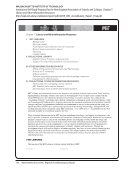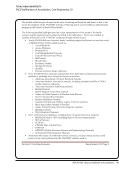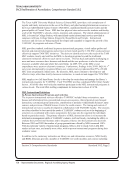136 · Representative Documents: Regional Accrediting Agency Reports
Massachusetts Institute of Technology
Institutional Self-Study Prepared for the New England Association of Schools and Colleges. Chapter 7:
Library and Other Information Resources
http://web.mit.edu/accreditation/report/pdfs/2009_MIT_Accreditation_Report_Final.pdf
Chapter 7: Library and Other Information Resources
Chapter 7 Page 90
to consistently keep systems running, and with IS&T’s network-services operation overall. In 2003 and
2005, customers expressed dissatisfaction with the help desk now, in a comparison with 10 other
universities surveyed by a consultant, MIT’s help desk ranks the highest.
While the 2008 survey showed across-the-board increases in satisfaction, the data also revealed some areas
for improvement. Principal concerns for all users were the effectiveness of spam-screening methods (which
were subsequently upgraded), the process for setting spam thresholds, the signal strength of the wireless
network in certain locations, and overall remote access from outside the United States.37
IS&T’s higher ratings overall reflect concentrated efforts to improve three core services—the network, e-
mail, and customer help. To address areas of current dissatisfaction, several projects are under way,
including a new e-mail/calendaring solution, the rollout of campuswide VoIP (technology for delivering
voice communications over Internet-protocol networks), and a full-scale overhaul of the wireless network
infrastructure to one of controller-based 802.11n access points that can regulate their signal strength
automatically. The satisfaction surveys help IS&T determine where needs are greatest, and they provide a
systematic mechanism for gauging the department’s effectiveness. We anticipate that the 2010 survey will
show satisfaction rising in additional areas, while pinpointing weaknesses that still require attention.
To further guide our efforts, IS&T created a student advisory board, ISTAB, to gather input and feedback
on services from student customers. ISTAB members raise issues directly with those responsible for
particular services within IS&T. In addition, ISTAB engages with a wide variety of other student groups,
including the MIT Undergraduate Association, Graduate Student Council, MIT Student Information
Processing Board, Association of Student Activities, and student IT representatives from schools and
departments. IS&T staff attend ISTAB meetings to respond to questions, make presentations, and
facilitate the conversations.
IV. PROJECTIONS
Technology for managing course materials
MIT uses three primary services to support its course content lifecycle. MIT OpenCourseWare (OCW) is
used for Web-based publication of virtually all MIT course content and is described more fully in Chapter
10, “Public Disclosure.” DSpace, addressed earlier in this chapter, is MIT’s institutional repository of
online research materials, built to save, share, and search research documents that are in digital form
(course materials, working papers, theses, conference papers, and more). Finally, Stellar is designed
specifically to support individual courses at MIT, providing a framework for posting course content and
other materials on the Web. In 2008-09 Stellar was used for over 80 percent of the classes at MIT.
Currently, these three course-content systems operate on independently developed platforms. Seeing the
need for integration without compromising the separate objectives of DSpace, OCW, and Stellar, MIT
launched the DOS (DSpace OCW Stellar) initiative. The goal of this initiative is to improve the
effectiveness of MIT educational systems by providing a common infrastructure and processes that enable
faculty to easily publish new teaching materials and easily use existing materials, while allowing students
to access those materials using the technology medium of their choice. Key technology enhancements
planned as part of this initiative include replacing OCW’s aging content- management system, replacing
or enhancing Stellar’s current platform, providing enterprise infrastructure support for DSpace, and
improving data interoperability.
37 A summary of the changes in ratings from May 1999 to October 2008 can be found at
http://web.mit.edu/ist/survey/2008/changes-in-ratings.pdf. For the complete report, see
http://web.mit.edu/ist/survey/2008/report.pdf.
Massachusetts Institute of Technology
Institutional Self-Study Prepared for the New England Association of Schools and Colleges. Chapter 7:
Library and Other Information Resources
http://web.mit.edu/accreditation/report/pdfs/2009_MIT_Accreditation_Report_Final.pdf
Chapter 7: Library and Other Information Resources
Chapter 7 Page 90
to consistently keep systems running, and with IS&T’s network-services operation overall. In 2003 and
2005, customers expressed dissatisfaction with the help desk now, in a comparison with 10 other
universities surveyed by a consultant, MIT’s help desk ranks the highest.
While the 2008 survey showed across-the-board increases in satisfaction, the data also revealed some areas
for improvement. Principal concerns for all users were the effectiveness of spam-screening methods (which
were subsequently upgraded), the process for setting spam thresholds, the signal strength of the wireless
network in certain locations, and overall remote access from outside the United States.37
IS&T’s higher ratings overall reflect concentrated efforts to improve three core services—the network, e-
mail, and customer help. To address areas of current dissatisfaction, several projects are under way,
including a new e-mail/calendaring solution, the rollout of campuswide VoIP (technology for delivering
voice communications over Internet-protocol networks), and a full-scale overhaul of the wireless network
infrastructure to one of controller-based 802.11n access points that can regulate their signal strength
automatically. The satisfaction surveys help IS&T determine where needs are greatest, and they provide a
systematic mechanism for gauging the department’s effectiveness. We anticipate that the 2010 survey will
show satisfaction rising in additional areas, while pinpointing weaknesses that still require attention.
To further guide our efforts, IS&T created a student advisory board, ISTAB, to gather input and feedback
on services from student customers. ISTAB members raise issues directly with those responsible for
particular services within IS&T. In addition, ISTAB engages with a wide variety of other student groups,
including the MIT Undergraduate Association, Graduate Student Council, MIT Student Information
Processing Board, Association of Student Activities, and student IT representatives from schools and
departments. IS&T staff attend ISTAB meetings to respond to questions, make presentations, and
facilitate the conversations.
IV. PROJECTIONS
Technology for managing course materials
MIT uses three primary services to support its course content lifecycle. MIT OpenCourseWare (OCW) is
used for Web-based publication of virtually all MIT course content and is described more fully in Chapter
10, “Public Disclosure.” DSpace, addressed earlier in this chapter, is MIT’s institutional repository of
online research materials, built to save, share, and search research documents that are in digital form
(course materials, working papers, theses, conference papers, and more). Finally, Stellar is designed
specifically to support individual courses at MIT, providing a framework for posting course content and
other materials on the Web. In 2008-09 Stellar was used for over 80 percent of the classes at MIT.
Currently, these three course-content systems operate on independently developed platforms. Seeing the
need for integration without compromising the separate objectives of DSpace, OCW, and Stellar, MIT
launched the DOS (DSpace OCW Stellar) initiative. The goal of this initiative is to improve the
effectiveness of MIT educational systems by providing a common infrastructure and processes that enable
faculty to easily publish new teaching materials and easily use existing materials, while allowing students
to access those materials using the technology medium of their choice. Key technology enhancements
planned as part of this initiative include replacing OCW’s aging content- management system, replacing
or enhancing Stellar’s current platform, providing enterprise infrastructure support for DSpace, and
improving data interoperability.
37 A summary of the changes in ratings from May 1999 to October 2008 can be found at
http://web.mit.edu/ist/survey/2008/changes-in-ratings.pdf. For the complete report, see
http://web.mit.edu/ist/survey/2008/report.pdf.
























































































































































































